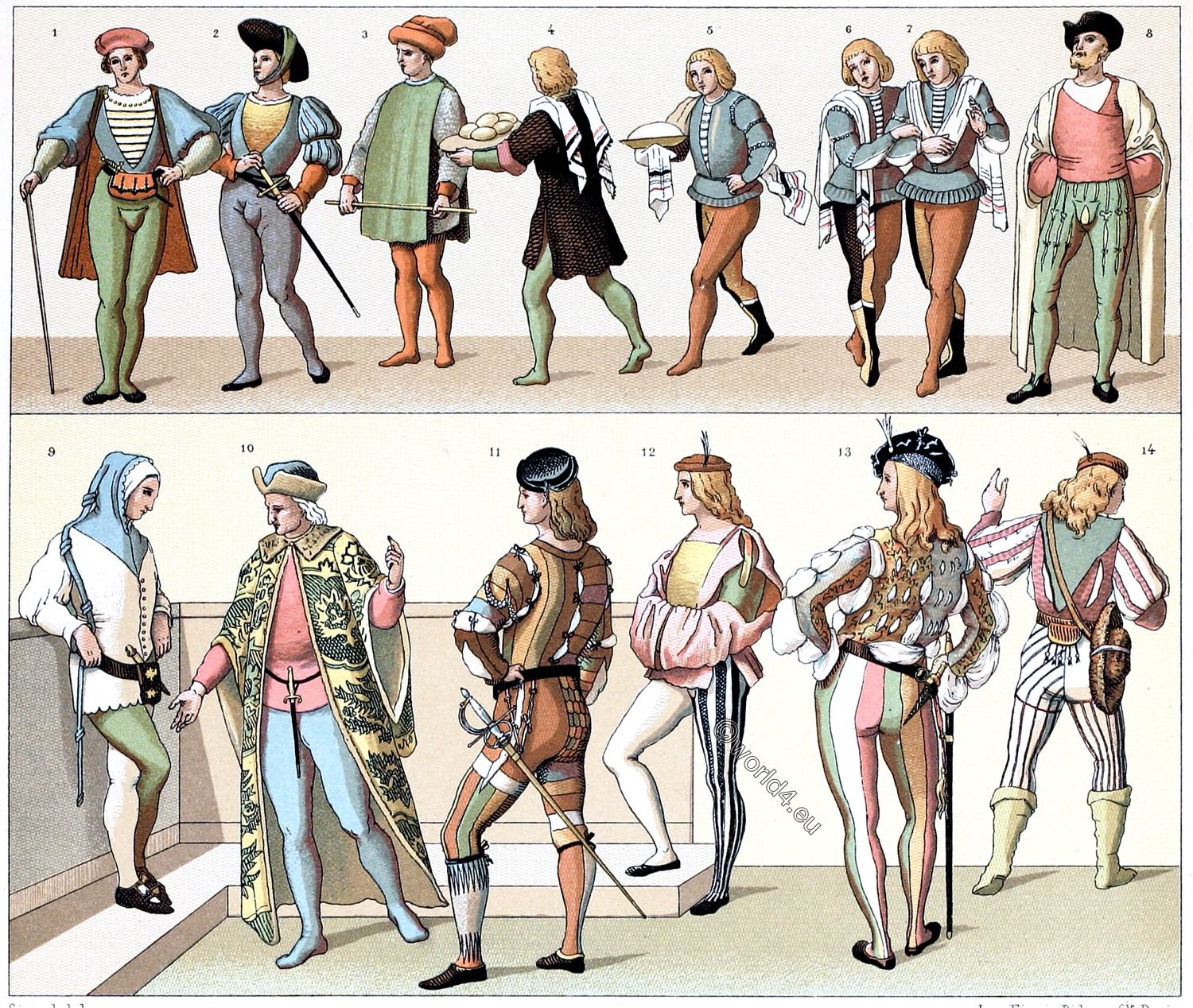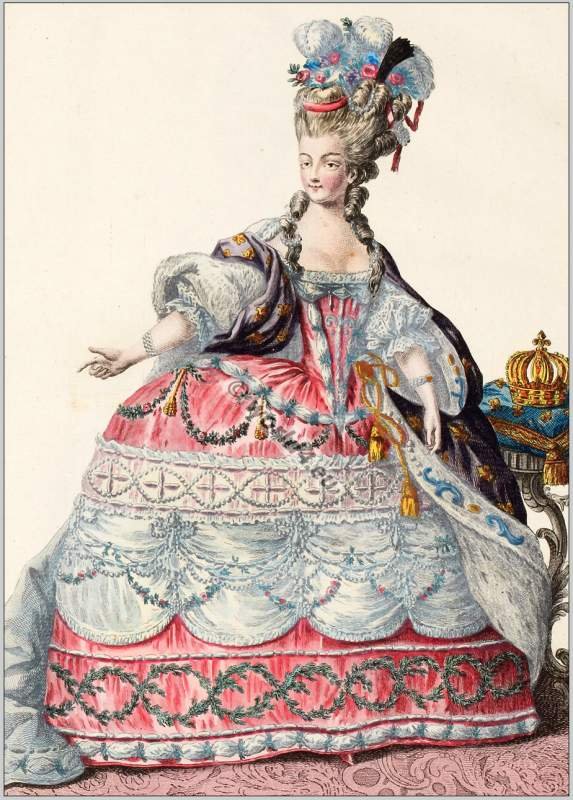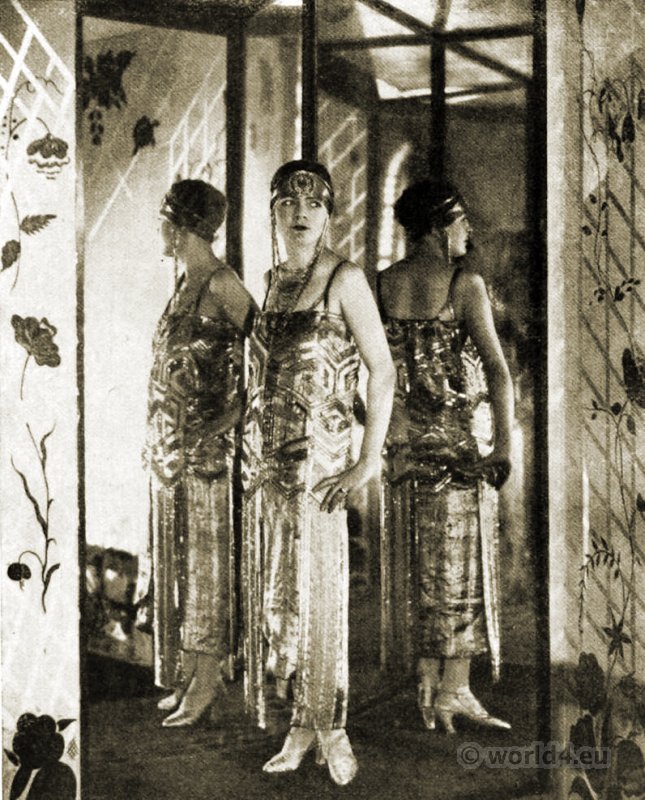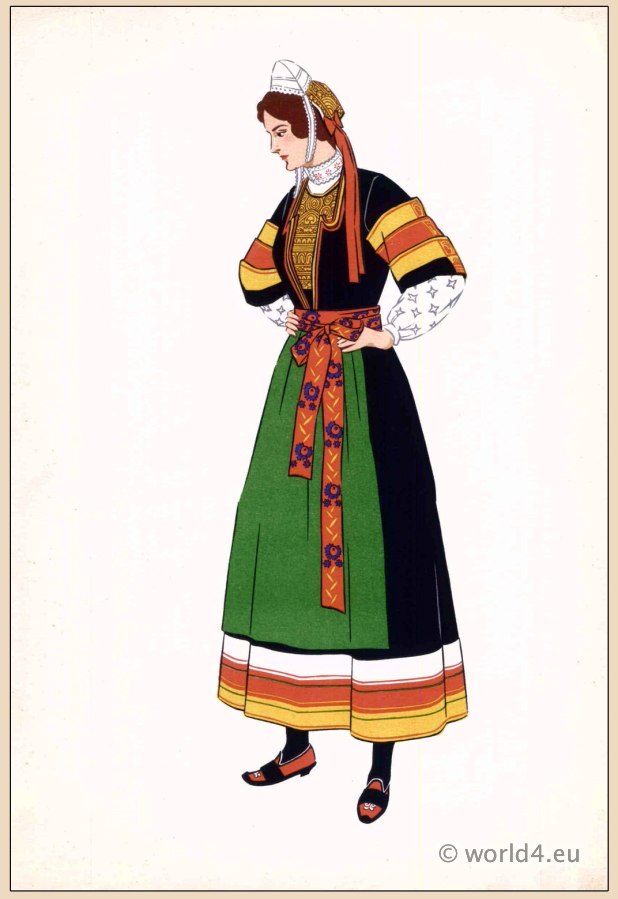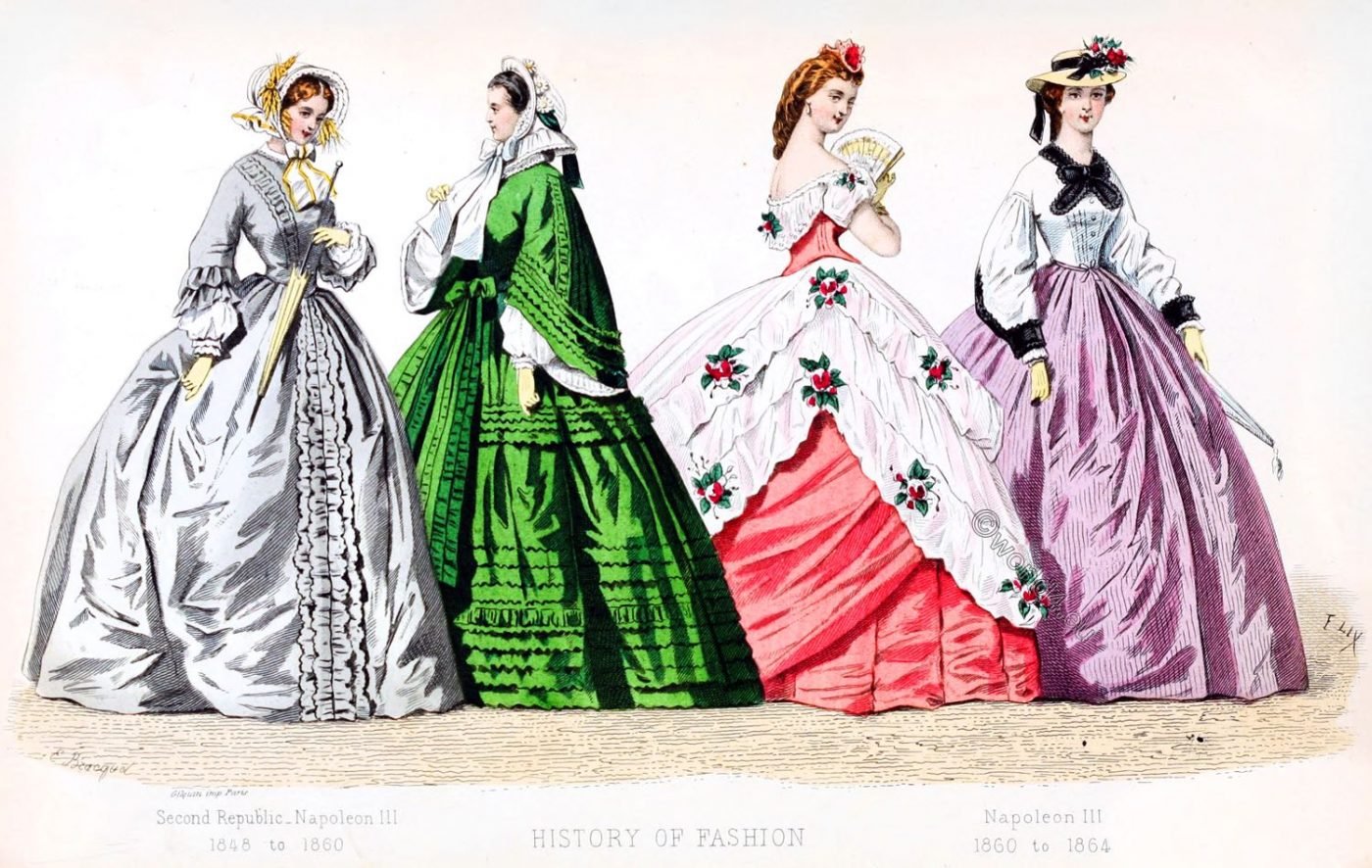
French fashion history. The Second Republic. 1848 to 1864.
Tricoloured stuffs of 1848 — Girondin mantles — Open gowns — Summer dresses — Kasawecks and their derivatives — Beaver bonnets; velvet bonnets, and satin or crape drawn bonnets — Cloches, Cornelia, Moldavian, and Josephine cloaks; mantles — Isly green — Opera cloaks — Numerous styles of dressing the hair: à la Marie Stuart, à la Valois, Leda, Proserpine, and Ceres — Marquise parasols — Jewellery — Straw bonnets — “Orleans” and “armure” — Work reticule or bag — “Chinas” — Pagoda sleeves — Waistcoats; basque bodices — New and economical canezous.
Tricoloured stuffs of 1848.
The Revolution of 1848 lasted too short a time to effect a change in dress. There is little to remark in that transient period, beyond the adoption of tricoloured materials in remembrance of 1830. Tricoloured ribbons were worn on caps, and on a few bonnets. For some months Girondin cloaks, with three rows of shaded lace, were in fashion; the cloaks were of muslin, and trimmed with frills worked in button-hole stitch. Bronze was the favourite colour for mantles.
Girondin mantles — Open gowns — Summer dresses.
The year 1848 was like its forerunner. The same materials, the same bodices, and the same sleeves continued to be worn. Small mantles called “grandmother,” and others, shawl-shaped, with little sleeves and three flounces, and others again, rounded behind, and trimmed with fringe or deep lace, were fashionable. Gowns were made open in front, with low square-cut Raphael bodices, the front and back gathered; and Marie Stuart headdresses were worn. As the light material of summer costumes was found trying to delicate persons, kasawecks or casaques, imported from Russia, were worn over them in the evening.
The Kasawecks and their derivatives.
The kasaweck was a sort of jacket coming below the waist, with a tight-fitting back, and wide, braided sleeves. The fronts were made loose, or to fit tight, according to taste. The Russian kasawecks were lined with fur, but ours were simply wadded. They were sometimes made of velvet and satin, but more frequently of cashmere or merino, and were occasionally worn under a shawl or mantle. They were known under several names, viz. “coin-du-feu,” “casaque,” “pardessus,” &c.; and there was quite a series of kasawecks, i. e. home kasawecks, garden kasawecks, girls’ kasawecks, grandmamma’s kasawecks, &c. Women of fashion, however, never wore them out of their own house in the daytime.
Beaver bonnets; velvet bonnets, and satin or crape drawn bonnets.
For several years wide-brimmed beaver bonnets were generally worn. They were given up because they were very expensive, unsuitable for full dress, and soon lost their color. Velvet bonnets succeeded them, trimmed with black lace or feathers, and drawn bonnets of satin or silk, or crape bonnets, on which were velvet heartsease, auriculas, or primroses.
Gowns, which remained about the same in shape, were cut more or less low, according as they were intended for morning or evening wear. Some were shorter than others; but fashion no longer allowed the ankle to be displayed as in 1829.
As regards material, the favorite woolens were cashmere, flannel, Glasgow cloth, and Amazon sateen; and in silks, plain or glace, “satin a la reine,” “pekin,” “gros d’Afrique,” &c.
Cloches, Cornelia, Moldavian, and Josephine cloaks; mantles.
An enumeration of all the cloaks, mantles, and pardessus would be tedious. But I must not omit to mention the bellshaped, or Greek cloak, also called the “Cornelia,” because its fulness and simplicity somewhat resembled the form of the Roman cloak. It had no sleeves and no seam on the shoulder, and could be gathered up over the arms like a shawl, at the pleasure of the wearer.
Another cloak, called the Moldavian, fell below the knee, the sleeves hung down wide at the back, and formed a square cape in front. We may also mention the double-cape beige cashmere mantle, edged with braid; the Josephine mantle, with one cape, and without shoulder-seam; and the shawl-mantle, the elegance of which depended chiefly on the trimming.
Black lace mantles were embellished by little ruchings of narrow lace, or by “frisettes,” a sort of braid which formed a frill on each side of a silk thread running through its entire length.
Isly green.
Among the favourite colours of the period was Isly green, so named in honor of the great victory obtained by Marshal Bugeaud, in 1844, over the armies of the Emperor of Morocco. Women wore a great deal of Algerian finery, or at any rate, their dressmakers got ideas from the events taking place in the colony, and made use of them in their work.
Opera cloaks. Numerous styles of dressing the hair: a la Marie Stuart, a la Valois, Leda, Proserpine, and Ceres.
“Sorties de bal,” or opera cloaks, were much worn at the same period. There was no dearth of dancing parties in the winter of 1849-50, and the number of entertainments in Paris astonishes the historian who remembers the political events of that same year.
The Marie Stuart and the Valois head-dresses were both in fashion; the latter being adopted by young and pretty women who wished to be conspicuous. The hair when dressed in this style was drawn back from the brow, and rolled over a pad right round the forehead. The “Druid” head-dress was composed of oak leaves; the “Nereid,” of all the flowers beloved by Naiads; the “Leda” consisted of little feathers of Barbary birds; the “Proserpine” of wild flowers, for this was Proserpine’s mode before she was abducted by Pluto. Lastly, the “Ceres,” consisting of the attributes of the genial goddess.
Long chains of large beads without clasps were worn round the neck, and reached to the waist; bracelets were of marcasite, enamel, diamonds, and cameos; velvet bands an inch or two in width were fastened closely round the throat.
Marquise parasols – Jewellery.
On the first appearance of sunshine, ladies provided themselves, when about to take a walk or pay a visit, with small parasols, white, pink, or green. These were called “marquises,” and were trimmed with broad lace.
Parasols were sometimes fashioned like small umbrellas, and were useful in case of a sudden shower. Soon afterwards they were bordered with a wreath of embroidered flowers, or with a satin stripe either of the same colour as the parasol, or blue or green on ecru, or violet on white or buff.
Bouquets of jewellery for the breast were worn by only a few, on account of their cost. One was exhibited at the Industrial Exhibition of 1849, which, although of only ordinary size, and containing neither diamonds, nor other precious stones, was valued at seven thousand francs. We must add that this ornament could be altered at pleasure so as to form a tiara, a bracelet, or a necklace.
In order to defy the Paris mud, ladies wore high-heeled kid boots, and gaiters of lamb-skin, buttoning on the outer side. Shoes were hardly seen except at balls, and were worn with beautiful hand-embroidered stockings, either of silk or Scotch thread.Very pretty trinkets were manufactured in green enamel, or enamel, gold, and pearls, or blue oxydized silver. Cap pins and brooches were made with pendants, either of pearls or diamonds. Arabesques were greatly appreciated by women of artistic taste.
How numerous were the toilets of one single day! First a dressing-gown, then a costume for mass, another for walking, another for the evening, others for the theatre or a ball! And all these without counting wedding-gowns, or mourning attire, or the dress of young girls or children.
Straw bonnets. “Orleans” and “armure”.
The great and typical novelty of 1850 was the introduction, first, of straw bonnets, and then of drawn bonnets. An endless variety were seen in places of fashionable resort. We need but enumerate the names of some of these; “paillassons,” “sewn straws,” “Belgian straws” with scalloped edges; and fancy straws in shell patterns, lozenges, &c.
This revived fashion of Italian straw bonnets lasted for several years. Women who could afford it, purchased expensive straws called “pailles de Florence” (Leghorns); the middle classes contented themselves, generally speaking, with sewn straws.
All these more or less expensive bonnets were trimmed with white ribbon, wheatears, cornflowers, and bows of ribbon or straw. Drawn bonnets were especially becoming to young girls; they were made of crepe lisse or tulle, and trimmed with bands of Italian straw. Many were made of Mechlin net, of horsehair, and of rice straw or chip. Black lace drawn bonnets were worn in general by women of a certain age.
We see that straw was approved of by every class, and in every station of life. A woolen material, still in use at the present day, was first manufactured in 1850. It was called “Orleans,” or “Orleance;” it was mixed and lustrous, was sometimes made in grey and black for half-mourning, and was principally used for gowns. “Armure,” an autumn stuff, was a woolen mixture, grey, violet, or green, with satin stripes.
The bodices of walking-dresses were still made to open in a V shape, with wide frilled sleeves and tight under sleeves, showing black velvet bracelets cleverly embroidered to represent coral. Some magnificent dresses were made of “satin a la reine,” brocaded with little “chine” bouquets, and trimmed with flounces either of equal depth or graduated.
Work reticule or bag.
In 1850, also, a little hand-bag or workbox was invented, of real utility, containing various little articles on the inside of the lid, viz. a needle-case, an instrument for the nails, a bodkin, scissors, a button-hook, and crochet-hooks.
The box itself held a thimble, a little pocket-book, a pencil, a looking-glass, and a pincushion. It would easily hold in addition, a purse, a handkerchief, a strip of embroidery or any other small piece of needlework, and reels of cotton. It was made in brown, black, or green leather, or in Russian leather lined with silk. Two leather straps made it very convenient to carry: it has been improved every succeeding year, and at the present day is in constant request (This was the well-known “Ladies’ companion.”). “Bourgeoises” and working women have adopted it; and it is of great service to all housewives. This was the origin of our present admirably convenient travelling-bags.
The following was a pretty costume of the period. A green or blue silk gown shot with black, with two or three graduated flounces, each flounce braided in the Greek key pattern, with narrow black velvet ribbon. The basque bodice (for all kinds of basques were worn) was trimmed with velvet. A fine white petticoat embroidered in open work was visible, if the dress were ever so little held up.
Silk was in such universal demand that fabulous prices were asked for it; and velvet was less esteemed than moire antique, or brocades, or gros de Tours, or satin-striped chines, or reps with velvet bands, or watered poplins, or Irish plaid poplins.
Nevertheless, shop-girls and workwomen made every possible sacrifice in order to procure a silk gown, in place of the Rouen cottons formerly worn.
A decided improvement in colors came into fashion. Ladies perceived, or were beginning to perceive, that each should wear those shades most becoming to her, and that, while following the popular fashions of Longchamps, she should adapt her dress to her own face and figure.
The various styles of gowns, mantles, and bonnets continued to increase in number.
“Chinas” — Pagoda sleeves — Waistcoats; basque bodices.
Chines were very numerous; there were “pastel chines,” bouquet of roses chines, chines with patterns arranged apron-fashion, chines with wreaths round the skirt, obelisk chines, &c. Tall and slight persons wore as many as five flounces, the upper one being gathered in with the skirt at the waist.
Pagoda sleeves brought back velvet and ribbon bracelets; they might almost have been called armlets, for the wrist was entirely hidden by bows and ends. This was very becoming to thin persons: those with round, plump arms wore a plain piece of velvet and a buckle.
Handkerchiefs were bordered in button-hole stitch, and for full dress were embroidered and trimmed with lace, or were made of “carre d’Angleterre.” Gloves of kid and lambskin were so greatly in request, that the manufacturers raised the price on the pretext that “the massacre of the poor little animals did not supply the demand.”
A few dressmakers revived the shaped sleeves terminated by a narrow wristband, and the “mousquetaire” or cavalier collars.
Waistcoats came into fashion in 1851, and were greatly worn under basque bodices; thus the ladies once more gave their sanction to the garment worn by Gilles, a buffoon of the eighteenth century.
New and economical canezous.
For morning wear, waistcoats were of black velvet, buttoning high to the throat; for afternoon, they were of embroidered silk, and had gilt buttons. For full dress, the buttons were of plain or chased gold, coral, turquoise, or garnet.
Canezous were very useful to wear with skirts that still retained their freshness. They were either bordered with button-hole stitch or with narrow lace. They were worn in summer. On the first sign of cold weather, muslin and gauze canezous gave way to jackets of thicker material.
Canezous were frequently worn by good managers, in order to utilize skirts whose bodices were partially worn out, and they were very economical.
We need not go further afield to account for the long duration of this fashion, both in town and country.
Source: The history of fashion in France, or, The dress of women from the Gallo-Roman period to the present time by Augustin Challamel, Frances Cashel Hoey, John Lillie. Publisher: New York, Scribner and Welford, 1882.




